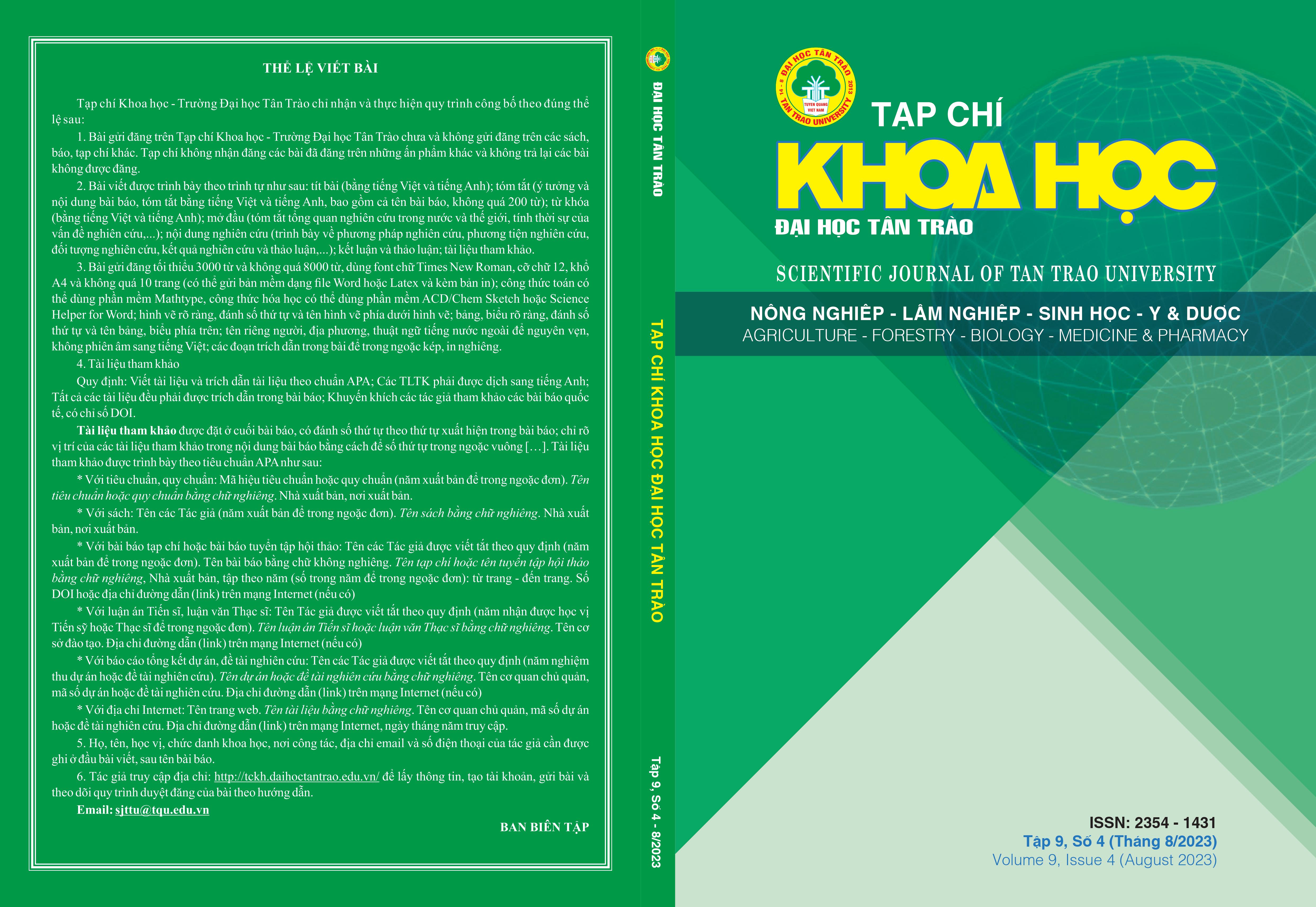ĐÁNH GIÁ KHẢ NĂNG SINH TRƯỞNG, NĂNG SUẤT VÀ CHẤT LƯỢNG MỘT SỐ GIỐNG DƯA LÊ (Cucumis melo L.) TRONG ĐIỀU KIỆN NHÀ MÀNG VỤ XUÂN HÈ 2022 TẠI THÁI NGUYÊN
DOI:
https://doi.org/10.51453/2354-1431/2023/852Tóm tắt
Thí nghiệm đánh giá khả năng sinh trưởng, năng suất và chất lượng của 6 giống dưa lê (04 giống nhập khẩu từ Hàn Quốc: Nami 102, M108, Bạch kim và Hanok No.1 và 2 giống dưa lê mới cho Viện Nghiên cứu rau quả lai tạo: Happy 6 và Happy 7). Thí nghiệm tiến hành ở vụ Xuân hè 2022 trong nhà màng Trường Đại học Nông Lâm Thái Nguyên. Kết quả nghiên cứu cho thấy các giống dưa lê có thời gian sinh trưởng từ 95-107 ngày. Nhóm giống dưa lê quả to (Nami 102, M108, Bạch kim) có khả năng sinh trưởng mạnh, nhưng tỷ lệ nhiễm bệnh phấn trắng, tuyến trùng cao hơn các giống khác, do vậy ảnh hưởng đến năng suất thực thu của giống. Một số giống có năng suất cao như Happy 6, Hanok No.1, Bạch Kim có năng suất từ 22,4-24,1 tạ/1000 m2. Các giống dưa lê nghiên cứu có độ brix dao động từ 11,2 - 14,8 %, hàm lượng vitamin C từ 60,67 – 74,23 mg/100g thịt quả, hàm lượng đường tổng số: 4,37 – 6,26%, vật chất khô từ 7,99 – 15,62 %. Nhóm giống dưa lê quả nhỏ (HP6, HP7 và Hanok No.1) có độ brix, đường tổng số và vật chất khô cao hơn các giống còn lại. Ngoài ra, giống HP6 và HP7 có mùi thơm khi chín.
Tải xuống
Tài liệu tham khảo
[1] Ta Thu Cuc (2005. Syllabus of vegetable growing techniques. Hanoi Publishing House 2005. pp. 176-184.
[2] Truong Thi Hong Hai, Tran Nhat Linh, Nguyen Dinh Thanh (2019). Comparison of growth, yield and quality of several varieties of melon (Cucumis melo L.) F1 in spring-summer 2018 greenhouse conditions in Thua Thien Hue-Vietnam. Hue University Journal of Science: Agriculture and Rural Development; ISSN 2588–1191 Vol. 128, No. 3A, 2019, pp. 57–66;
[3] Ngo Thi Hanh, Nguyen Thi Hong Hanh, Tran Thi Hong, Pham Thi Minh Hue, Vu Ngoc Huy (2020). The results of the study selected the breeding of hybrid yellow melons. Journal of Agriculture and Rural Development - 3/2020. Pg.111-117
[4] Le Thi Kieu Oanh, Ngo Thi Hanh, Tran Dinh Ha (2018). Study the growth, yield and quality of some Korean melon varieties in Thai Nguyen province-Vietnam. Journal of Agriculture and Rural Development - 11/2018. Pg.74-81.
[5] Adams C. F. (1975). Nutritive value of American foods in common units, U.S. Department of Agriculture, Agric Handbook, 425, 29.
[6] Fruit and Vegetable Research Institute (2021). Choose to successfully create 2 varieties of yellow melon Happy 6, Happy 7. http://favri.org.vn/index.php/vi/tin-tuc-noi-bat/1146-chon-tao-thanh-cong-2-giong-dua-le-vang-happy-6-happy-7
[7] Lester Gene (1997). Melon (Cucumis melon L.) fruit nutritional quality and health functionality, Horttechnology, 1997.
[8] Lee, W. J., Lee, J. H., Jang, K. S., Choi, Y. H., Kim, H. T. and Choi, G. J., 2015. Development of efficient screening methods for melon plants resistant to Fusarium oxysporum f. sp. melonis. Korean J. Hortic. Sci. Technol. 33:70-82.
[9] Seo Y. and Kim Y. H., 2017. Potential Reasons for Prevalence of Fusarium Wilt in Oriental Melon in Korea. Plant Pathol. J. 33(3) : 249-263.
Tải xuống
Đã Xuất bản
Cách trích dẫn
Số
Chuyên mục
Giấy phép

Tác phẩm này được cấp phép theo Giấy phép Quốc tế Creative Commons Attribution-ShareAlike 4.0 .
Bài báo được xuất bản ở Tạp chí Khoa học Đại học Tân Trào được cấp phép theo giấy phép Ghi công - Chia sẻ tương tự 4.0 Quốc tế (CC BY-SA). Theo đó, các tác giả khác có thể sao chép, chuyển đổi hay phân phối lại các bài báo này với mục đích hợp pháp trên mọi phương tiện, với điều kiện họ trích dẫn tác giả, Tạp chí Khoa học Đại học Tân Trào và đường link đến bản quyền; nêu rõ các thay đổi đã thực hiện và các nghiên cứu đăng lại được tiến hành theo cùng một bản quyền.
Bản quyền bài báo thuộc về các tác giả, không hạn chế số lượng. Tạp chí Khoa học Tân Trào được cấp giấy phép không độc quyền để xuất bản bài báo với tư cách nhà xuất bản nguồn, kèm theo quyền thương mại để in các bài báo cung cấp cho các thư viện và cá nhân.
Mặc dù các điều khoản của giấy phép CC BY-SA không dành cho các tác giả (với tư cách là người giữ bản quyền của bài báo, họ không bị hạn chế về quyền hạn), khi gửi bài tới Tạp chí Khoa học Đại học Tân Trào, tác giả cần đáp ứng quyền của độc giả, và cần cấp quyền cho bên thứ 3 sử dụng bài báo của họ trong phạm vi của giấy phép.






